ChemExec Pharmacy: System Analysis and Design Report - BIT230
VerifiedAdded on 2022/12/27
|17
|3760
|44
Report
AI Summary
This report details a system analysis and design project for ChemExec, a Melbourne-based pharmacy business. It begins with a system scope document, outlining the business problem, ChemExec's need for a new web-based application to streamline order processing, and the benefits of improved customer service and market expansion. The report then delves into FURPS+ requirements, defining functional, usability, reliability, performance, and supportability aspects of the proposed system. Functional requirements include features like order acceptance and business operation streamlining. The usability section addresses performance, productivity, and accessibility. Reliability considerations cover system failure, accuracy, and security. Performance requirements discuss operation speeds and memory consumption. The report also includes a list of functional requirements in an event table and concludes with a use case diagram illustrating system interactions. The project aims to modernize ChemExec's operations and enhance its market competitiveness.
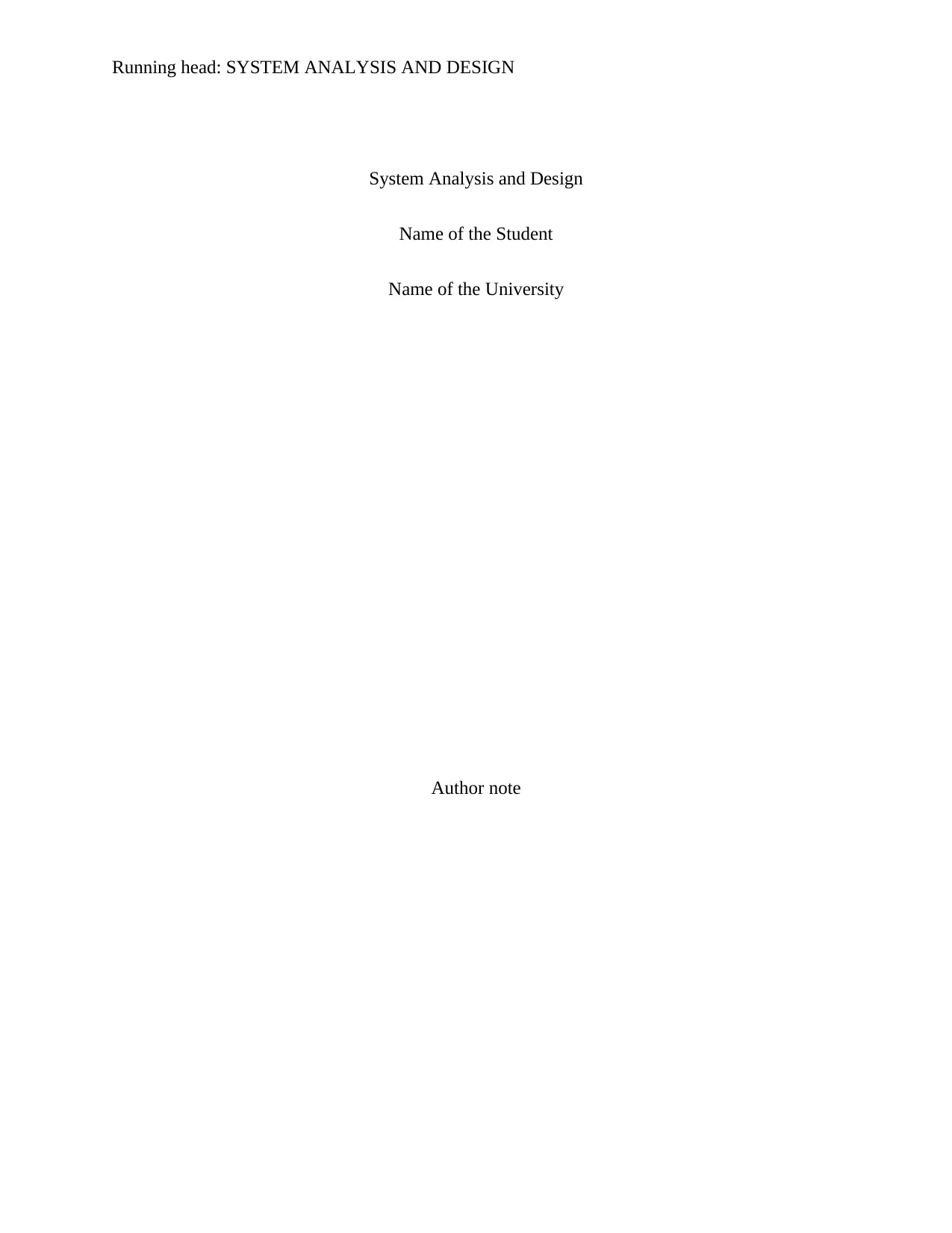
Running head: SYSTEM ANALYSIS AND DESIGN
System Analysis and Design
Name of the Student
Name of the University
Author note
System Analysis and Design
Name of the Student
Name of the University
Author note
Paraphrase This Document
Need a fresh take? Get an instant paraphrase of this document with our AI Paraphraser
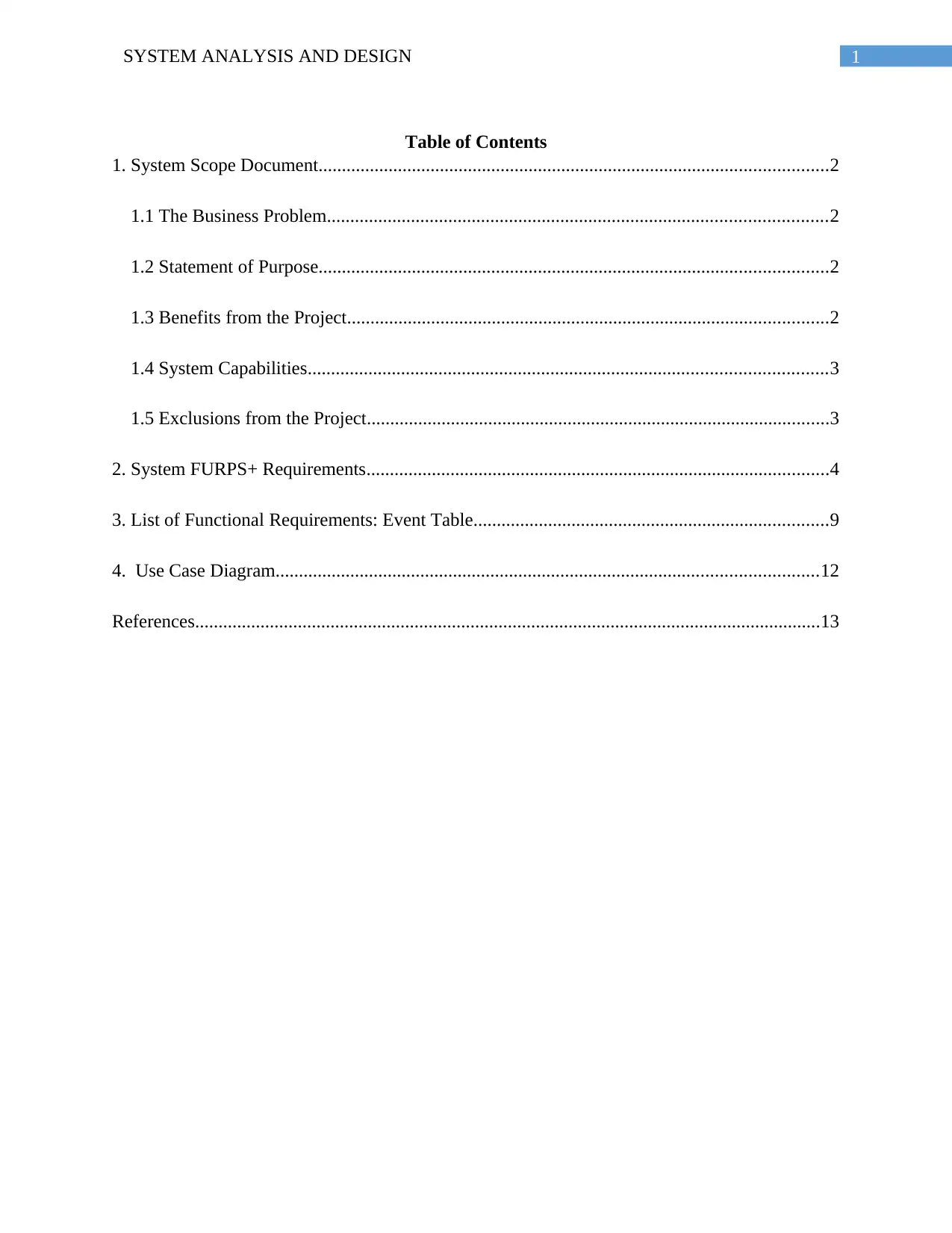
1SYSTEM ANALYSIS AND DESIGN
Table of Contents
1. System Scope Document.............................................................................................................2
1.1 The Business Problem...........................................................................................................2
1.2 Statement of Purpose.............................................................................................................2
1.3 Benefits from the Project.......................................................................................................2
1.4 System Capabilities...............................................................................................................3
1.5 Exclusions from the Project...................................................................................................3
2. System FURPS+ Requirements...................................................................................................4
3. List of Functional Requirements: Event Table............................................................................9
4. Use Case Diagram....................................................................................................................12
References......................................................................................................................................13
Table of Contents
1. System Scope Document.............................................................................................................2
1.1 The Business Problem...........................................................................................................2
1.2 Statement of Purpose.............................................................................................................2
1.3 Benefits from the Project.......................................................................................................2
1.4 System Capabilities...............................................................................................................3
1.5 Exclusions from the Project...................................................................................................3
2. System FURPS+ Requirements...................................................................................................4
3. List of Functional Requirements: Event Table............................................................................9
4. Use Case Diagram....................................................................................................................12
References......................................................................................................................................13
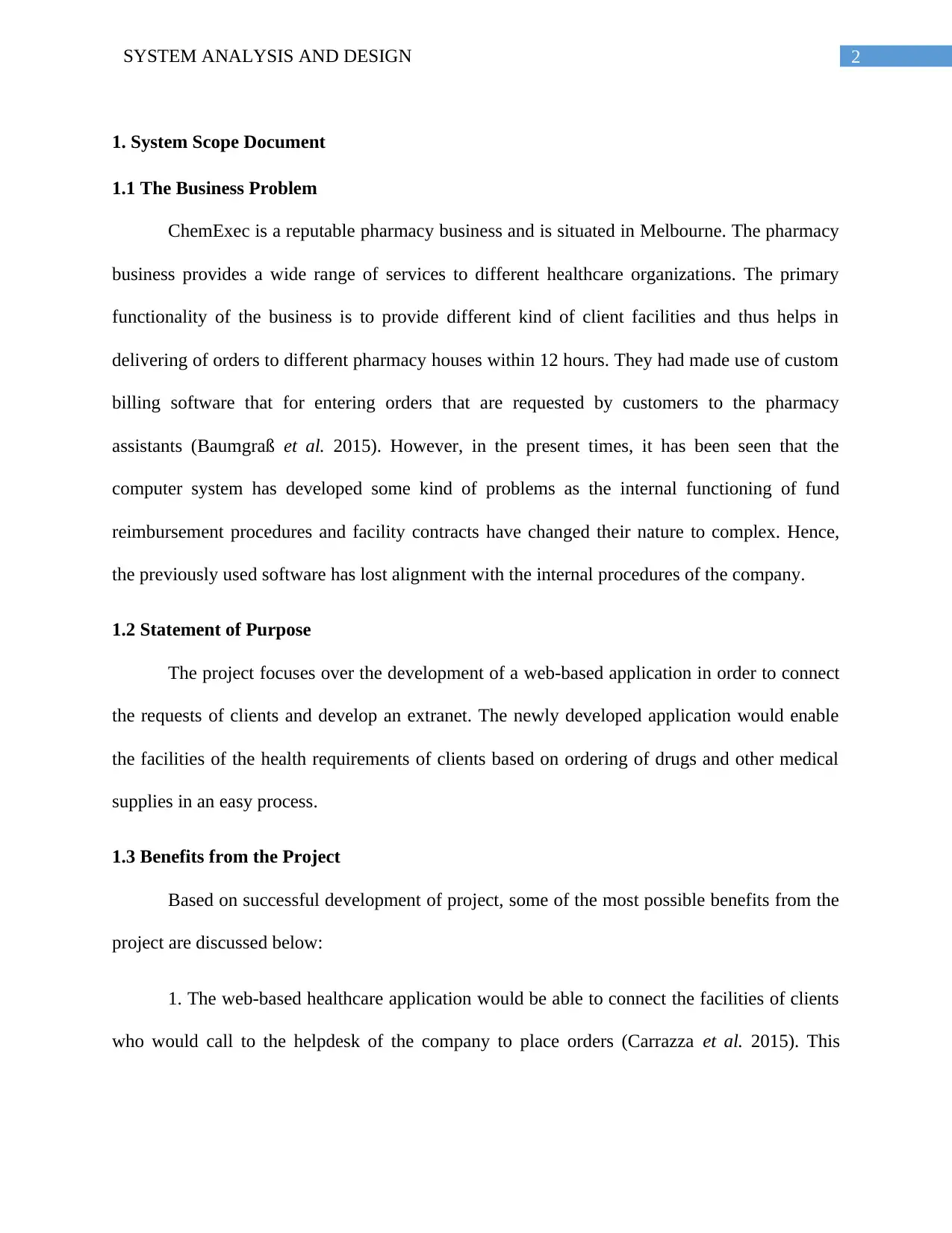
2SYSTEM ANALYSIS AND DESIGN
1. System Scope Document
1.1 The Business Problem
ChemExec is a reputable pharmacy business and is situated in Melbourne. The pharmacy
business provides a wide range of services to different healthcare organizations. The primary
functionality of the business is to provide different kind of client facilities and thus helps in
delivering of orders to different pharmacy houses within 12 hours. They had made use of custom
billing software that for entering orders that are requested by customers to the pharmacy
assistants (Baumgraß et al. 2015). However, in the present times, it has been seen that the
computer system has developed some kind of problems as the internal functioning of fund
reimbursement procedures and facility contracts have changed their nature to complex. Hence,
the previously used software has lost alignment with the internal procedures of the company.
1.2 Statement of Purpose
The project focuses over the development of a web-based application in order to connect
the requests of clients and develop an extranet. The newly developed application would enable
the facilities of the health requirements of clients based on ordering of drugs and other medical
supplies in an easy process.
1.3 Benefits from the Project
Based on successful development of project, some of the most possible benefits from the
project are discussed below:
1. The web-based healthcare application would be able to connect the facilities of clients
who would call to the helpdesk of the company to place orders (Carrazza et al. 2015). This
1. System Scope Document
1.1 The Business Problem
ChemExec is a reputable pharmacy business and is situated in Melbourne. The pharmacy
business provides a wide range of services to different healthcare organizations. The primary
functionality of the business is to provide different kind of client facilities and thus helps in
delivering of orders to different pharmacy houses within 12 hours. They had made use of custom
billing software that for entering orders that are requested by customers to the pharmacy
assistants (Baumgraß et al. 2015). However, in the present times, it has been seen that the
computer system has developed some kind of problems as the internal functioning of fund
reimbursement procedures and facility contracts have changed their nature to complex. Hence,
the previously used software has lost alignment with the internal procedures of the company.
1.2 Statement of Purpose
The project focuses over the development of a web-based application in order to connect
the requests of clients and develop an extranet. The newly developed application would enable
the facilities of the health requirements of clients based on ordering of drugs and other medical
supplies in an easy process.
1.3 Benefits from the Project
Based on successful development of project, some of the most possible benefits from the
project are discussed below:
1. The web-based healthcare application would be able to connect the facilities of clients
who would call to the helpdesk of the company to place orders (Carrazza et al. 2015). This
⊘ This is a preview!⊘
Do you want full access?
Subscribe today to unlock all pages.

Trusted by 1+ million students worldwide
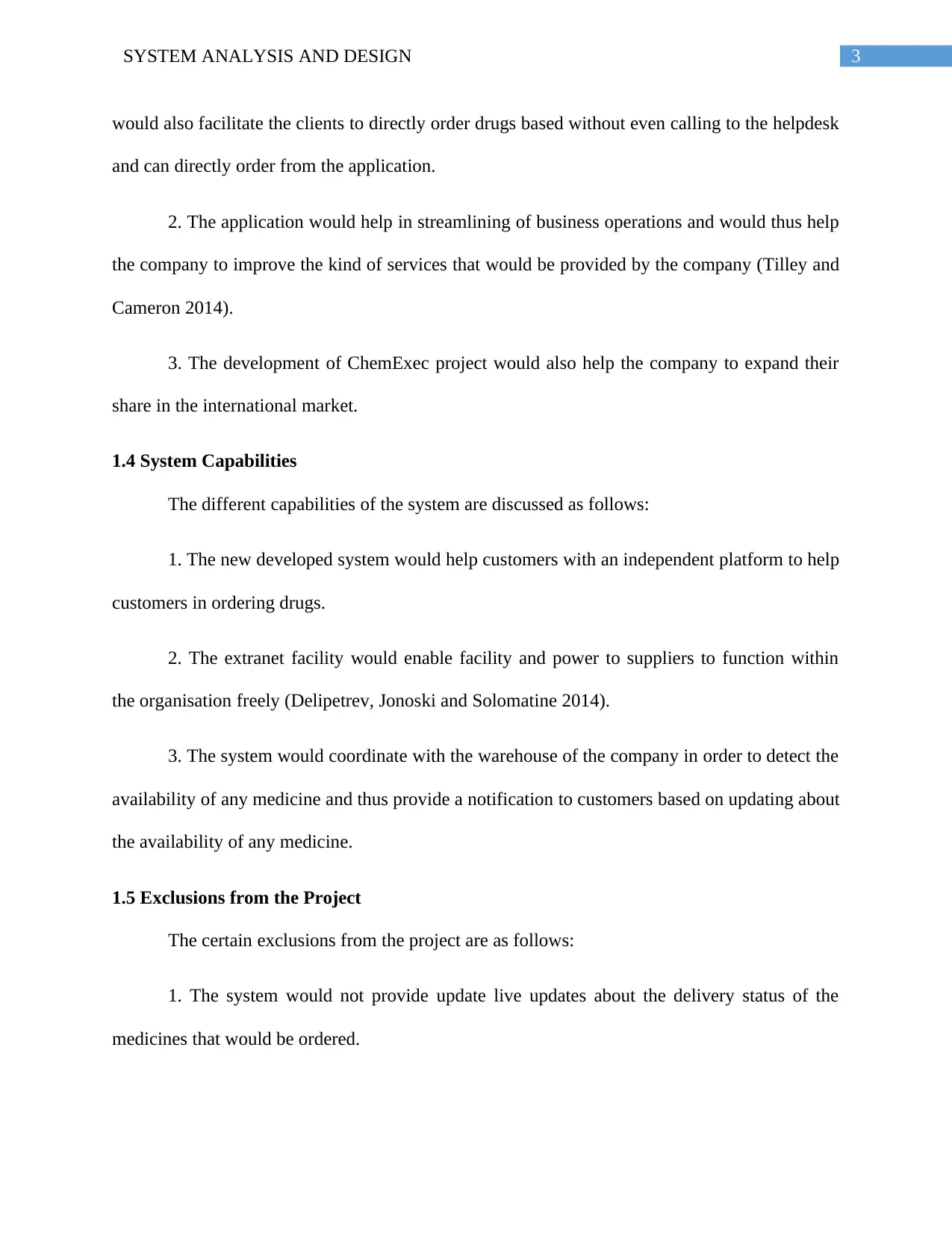
3SYSTEM ANALYSIS AND DESIGN
would also facilitate the clients to directly order drugs based without even calling to the helpdesk
and can directly order from the application.
2. The application would help in streamlining of business operations and would thus help
the company to improve the kind of services that would be provided by the company (Tilley and
Cameron 2014).
3. The development of ChemExec project would also help the company to expand their
share in the international market.
1.4 System Capabilities
The different capabilities of the system are discussed as follows:
1. The new developed system would help customers with an independent platform to help
customers in ordering drugs.
2. The extranet facility would enable facility and power to suppliers to function within
the organisation freely (Delipetrev, Jonoski and Solomatine 2014).
3. The system would coordinate with the warehouse of the company in order to detect the
availability of any medicine and thus provide a notification to customers based on updating about
the availability of any medicine.
1.5 Exclusions from the Project
The certain exclusions from the project are as follows:
1. The system would not provide update live updates about the delivery status of the
medicines that would be ordered.
would also facilitate the clients to directly order drugs based without even calling to the helpdesk
and can directly order from the application.
2. The application would help in streamlining of business operations and would thus help
the company to improve the kind of services that would be provided by the company (Tilley and
Cameron 2014).
3. The development of ChemExec project would also help the company to expand their
share in the international market.
1.4 System Capabilities
The different capabilities of the system are discussed as follows:
1. The new developed system would help customers with an independent platform to help
customers in ordering drugs.
2. The extranet facility would enable facility and power to suppliers to function within
the organisation freely (Delipetrev, Jonoski and Solomatine 2014).
3. The system would coordinate with the warehouse of the company in order to detect the
availability of any medicine and thus provide a notification to customers based on updating about
the availability of any medicine.
1.5 Exclusions from the Project
The certain exclusions from the project are as follows:
1. The system would not provide update live updates about the delivery status of the
medicines that would be ordered.
Paraphrase This Document
Need a fresh take? Get an instant paraphrase of this document with our AI Paraphraser
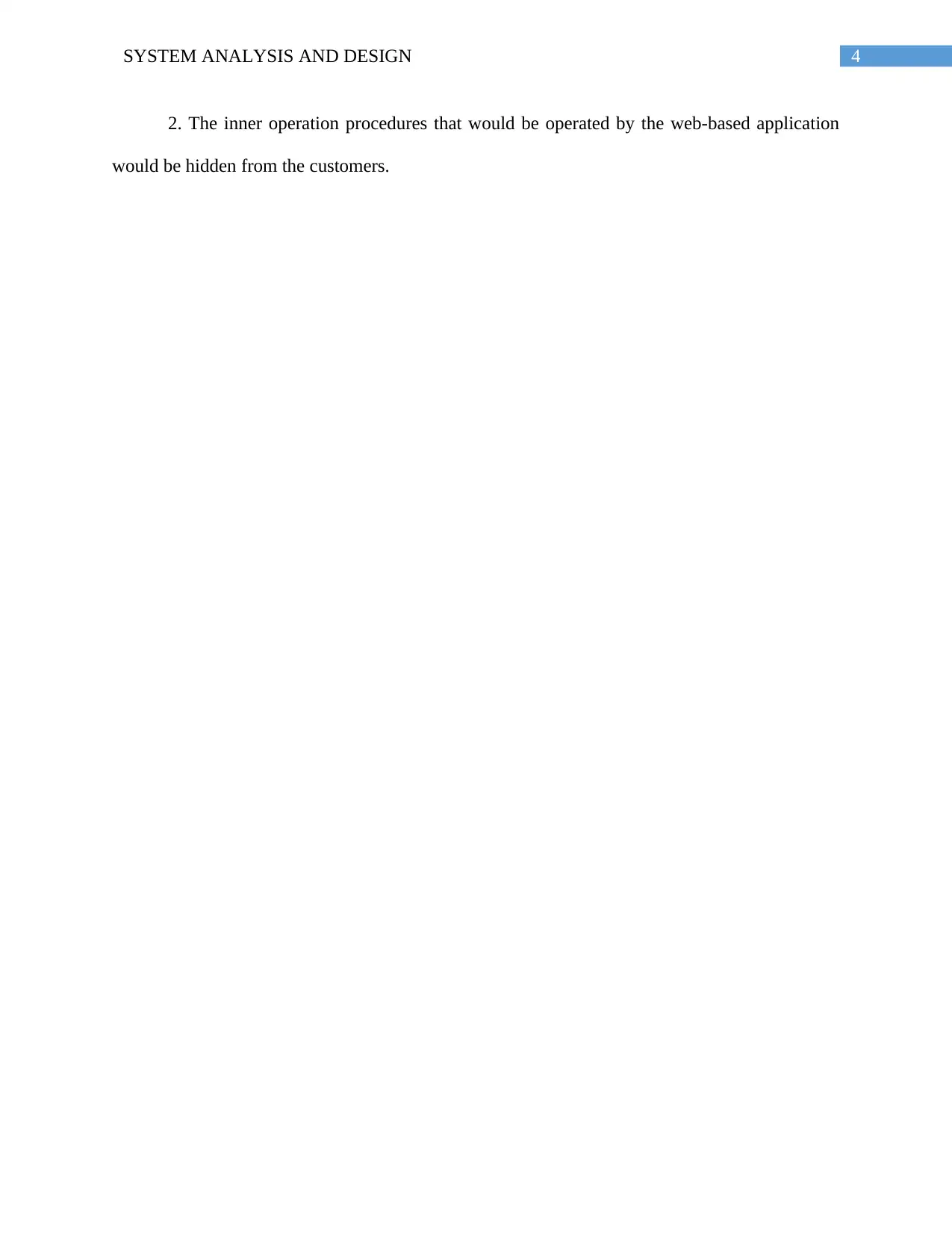
4SYSTEM ANALYSIS AND DESIGN
2. The inner operation procedures that would be operated by the web-based application
would be hidden from the customers.
2. The inner operation procedures that would be operated by the web-based application
would be hidden from the customers.
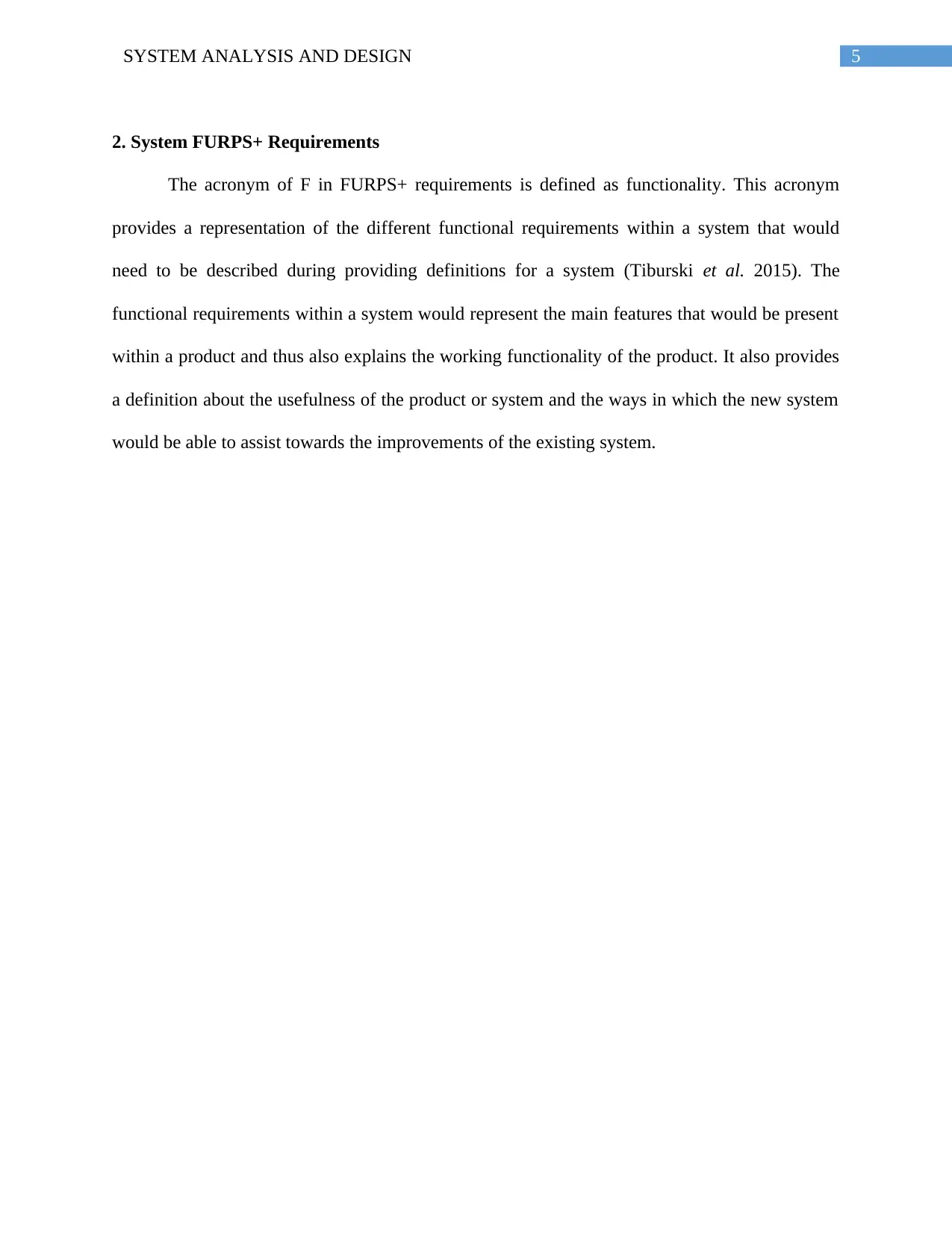
5SYSTEM ANALYSIS AND DESIGN
2. System FURPS+ Requirements
The acronym of F in FURPS+ requirements is defined as functionality. This acronym
provides a representation of the different functional requirements within a system that would
need to be described during providing definitions for a system (Tiburski et al. 2015). The
functional requirements within a system would represent the main features that would be present
within a product and thus also explains the working functionality of the product. It also provides
a definition about the usefulness of the product or system and the ways in which the new system
would be able to assist towards the improvements of the existing system.
2. System FURPS+ Requirements
The acronym of F in FURPS+ requirements is defined as functionality. This acronym
provides a representation of the different functional requirements within a system that would
need to be described during providing definitions for a system (Tiburski et al. 2015). The
functional requirements within a system would represent the main features that would be present
within a product and thus also explains the working functionality of the product. It also provides
a definition about the usefulness of the product or system and the ways in which the new system
would be able to assist towards the improvements of the existing system.
⊘ This is a preview!⊘
Do you want full access?
Subscribe today to unlock all pages.

Trusted by 1+ million students worldwide
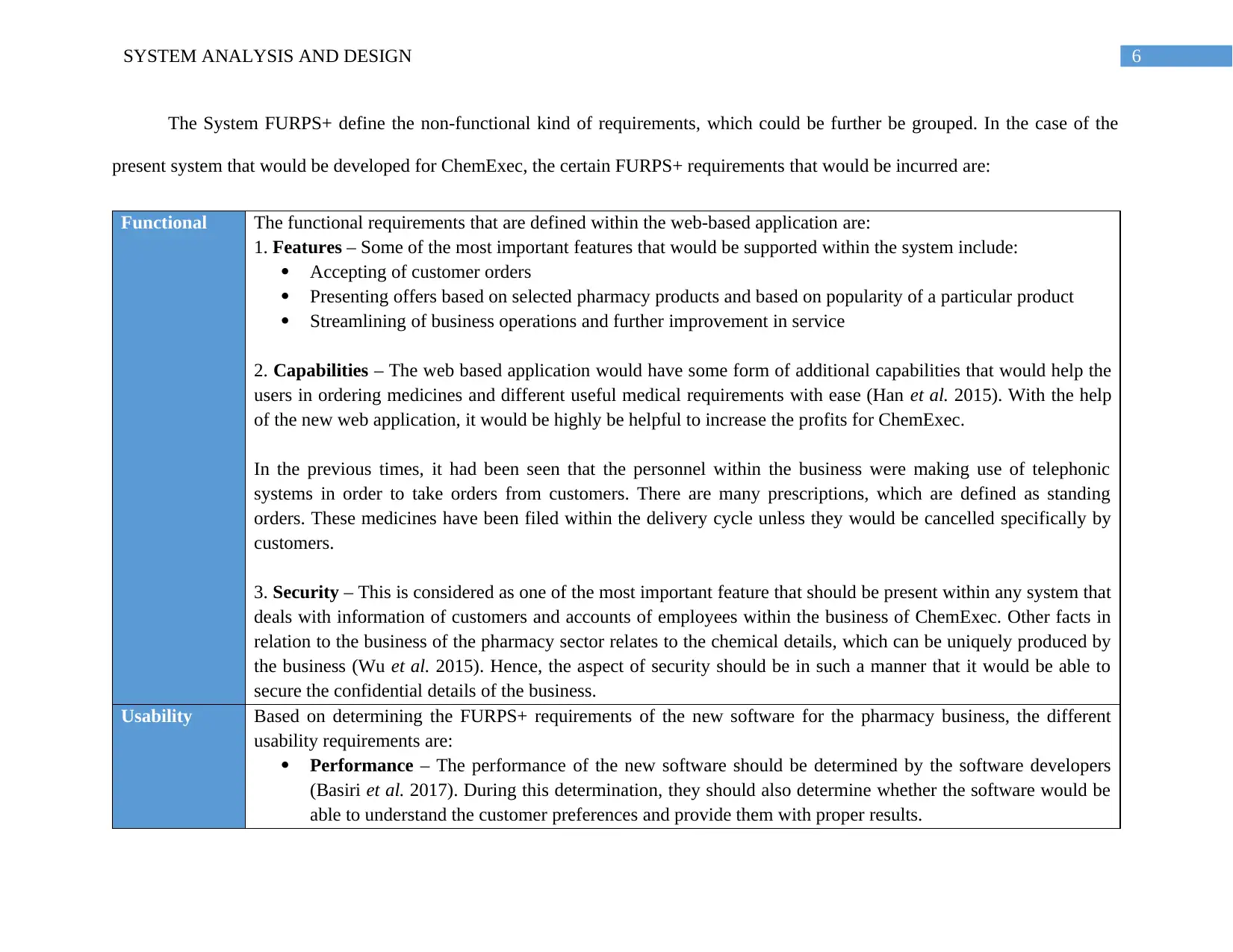
6SYSTEM ANALYSIS AND DESIGN
The System FURPS+ define the non-functional kind of requirements, which could be further be grouped. In the case of the
present system that would be developed for ChemExec, the certain FURPS+ requirements that would be incurred are:
Functional The functional requirements that are defined within the web-based application are:
1. Features – Some of the most important features that would be supported within the system include:
Accepting of customer orders
Presenting offers based on selected pharmacy products and based on popularity of a particular product
Streamlining of business operations and further improvement in service
2. Capabilities – The web based application would have some form of additional capabilities that would help the
users in ordering medicines and different useful medical requirements with ease (Han et al. 2015). With the help
of the new web application, it would be highly be helpful to increase the profits for ChemExec.
In the previous times, it had been seen that the personnel within the business were making use of telephonic
systems in order to take orders from customers. There are many prescriptions, which are defined as standing
orders. These medicines have been filed within the delivery cycle unless they would be cancelled specifically by
customers.
3. Security – This is considered as one of the most important feature that should be present within any system that
deals with information of customers and accounts of employees within the business of ChemExec. Other facts in
relation to the business of the pharmacy sector relates to the chemical details, which can be uniquely produced by
the business (Wu et al. 2015). Hence, the aspect of security should be in such a manner that it would be able to
secure the confidential details of the business.
Usability Based on determining the FURPS+ requirements of the new software for the pharmacy business, the different
usability requirements are:
Performance – The performance of the new software should be determined by the software developers
(Basiri et al. 2017). During this determination, they should also determine whether the software would be
able to understand the customer preferences and provide them with proper results.
The System FURPS+ define the non-functional kind of requirements, which could be further be grouped. In the case of the
present system that would be developed for ChemExec, the certain FURPS+ requirements that would be incurred are:
Functional The functional requirements that are defined within the web-based application are:
1. Features – Some of the most important features that would be supported within the system include:
Accepting of customer orders
Presenting offers based on selected pharmacy products and based on popularity of a particular product
Streamlining of business operations and further improvement in service
2. Capabilities – The web based application would have some form of additional capabilities that would help the
users in ordering medicines and different useful medical requirements with ease (Han et al. 2015). With the help
of the new web application, it would be highly be helpful to increase the profits for ChemExec.
In the previous times, it had been seen that the personnel within the business were making use of telephonic
systems in order to take orders from customers. There are many prescriptions, which are defined as standing
orders. These medicines have been filed within the delivery cycle unless they would be cancelled specifically by
customers.
3. Security – This is considered as one of the most important feature that should be present within any system that
deals with information of customers and accounts of employees within the business of ChemExec. Other facts in
relation to the business of the pharmacy sector relates to the chemical details, which can be uniquely produced by
the business (Wu et al. 2015). Hence, the aspect of security should be in such a manner that it would be able to
secure the confidential details of the business.
Usability Based on determining the FURPS+ requirements of the new software for the pharmacy business, the different
usability requirements are:
Performance – The performance of the new software should be determined by the software developers
(Basiri et al. 2017). During this determination, they should also determine whether the software would be
able to understand the customer preferences and provide them with proper results.
Paraphrase This Document
Need a fresh take? Get an instant paraphrase of this document with our AI Paraphraser
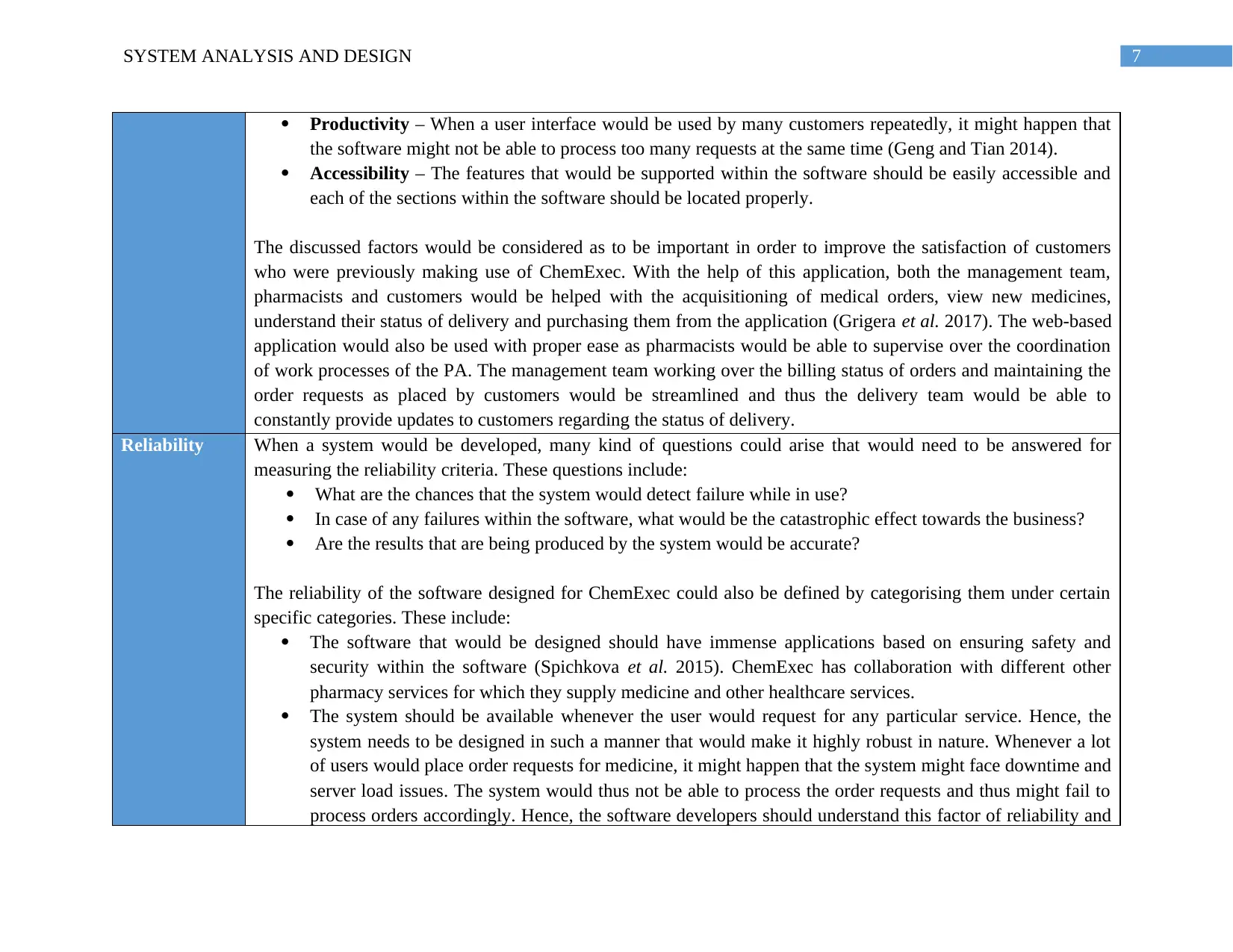
7SYSTEM ANALYSIS AND DESIGN
Productivity – When a user interface would be used by many customers repeatedly, it might happen that
the software might not be able to process too many requests at the same time (Geng and Tian 2014).
Accessibility – The features that would be supported within the software should be easily accessible and
each of the sections within the software should be located properly.
The discussed factors would be considered as to be important in order to improve the satisfaction of customers
who were previously making use of ChemExec. With the help of this application, both the management team,
pharmacists and customers would be helped with the acquisitioning of medical orders, view new medicines,
understand their status of delivery and purchasing them from the application (Grigera et al. 2017). The web-based
application would also be used with proper ease as pharmacists would be able to supervise over the coordination
of work processes of the PA. The management team working over the billing status of orders and maintaining the
order requests as placed by customers would be streamlined and thus the delivery team would be able to
constantly provide updates to customers regarding the status of delivery.
Reliability When a system would be developed, many kind of questions could arise that would need to be answered for
measuring the reliability criteria. These questions include:
What are the chances that the system would detect failure while in use?
In case of any failures within the software, what would be the catastrophic effect towards the business?
Are the results that are being produced by the system would be accurate?
The reliability of the software designed for ChemExec could also be defined by categorising them under certain
specific categories. These include:
The software that would be designed should have immense applications based on ensuring safety and
security within the software (Spichkova et al. 2015). ChemExec has collaboration with different other
pharmacy services for which they supply medicine and other healthcare services.
The system should be available whenever the user would request for any particular service. Hence, the
system needs to be designed in such a manner that would make it highly robust in nature. Whenever a lot
of users would place order requests for medicine, it might happen that the system might face downtime and
server load issues. The system would thus not be able to process the order requests and thus might fail to
process orders accordingly. Hence, the software developers should understand this factor of reliability and
Productivity – When a user interface would be used by many customers repeatedly, it might happen that
the software might not be able to process too many requests at the same time (Geng and Tian 2014).
Accessibility – The features that would be supported within the software should be easily accessible and
each of the sections within the software should be located properly.
The discussed factors would be considered as to be important in order to improve the satisfaction of customers
who were previously making use of ChemExec. With the help of this application, both the management team,
pharmacists and customers would be helped with the acquisitioning of medical orders, view new medicines,
understand their status of delivery and purchasing them from the application (Grigera et al. 2017). The web-based
application would also be used with proper ease as pharmacists would be able to supervise over the coordination
of work processes of the PA. The management team working over the billing status of orders and maintaining the
order requests as placed by customers would be streamlined and thus the delivery team would be able to
constantly provide updates to customers regarding the status of delivery.
Reliability When a system would be developed, many kind of questions could arise that would need to be answered for
measuring the reliability criteria. These questions include:
What are the chances that the system would detect failure while in use?
In case of any failures within the software, what would be the catastrophic effect towards the business?
Are the results that are being produced by the system would be accurate?
The reliability of the software designed for ChemExec could also be defined by categorising them under certain
specific categories. These include:
The software that would be designed should have immense applications based on ensuring safety and
security within the software (Spichkova et al. 2015). ChemExec has collaboration with different other
pharmacy services for which they supply medicine and other healthcare services.
The system should be available whenever the user would request for any particular service. Hence, the
system needs to be designed in such a manner that would make it highly robust in nature. Whenever a lot
of users would place order requests for medicine, it might happen that the system might face downtime and
server load issues. The system would thus not be able to process the order requests and thus might fail to
process orders accordingly. Hence, the software developers should understand this factor of reliability and
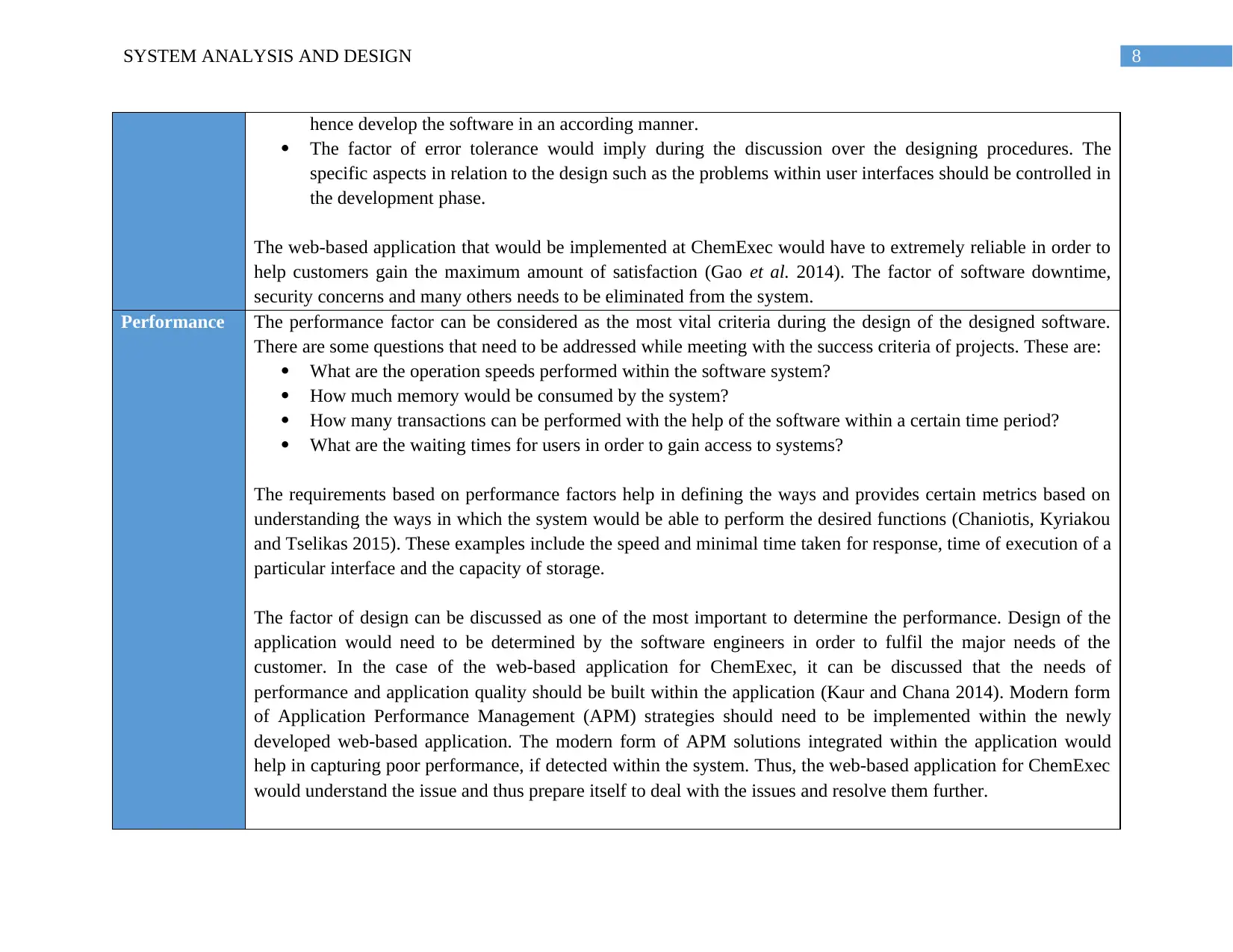
8SYSTEM ANALYSIS AND DESIGN
hence develop the software in an according manner.
The factor of error tolerance would imply during the discussion over the designing procedures. The
specific aspects in relation to the design such as the problems within user interfaces should be controlled in
the development phase.
The web-based application that would be implemented at ChemExec would have to extremely reliable in order to
help customers gain the maximum amount of satisfaction (Gao et al. 2014). The factor of software downtime,
security concerns and many others needs to be eliminated from the system.
Performance The performance factor can be considered as the most vital criteria during the design of the designed software.
There are some questions that need to be addressed while meeting with the success criteria of projects. These are:
What are the operation speeds performed within the software system?
How much memory would be consumed by the system?
How many transactions can be performed with the help of the software within a certain time period?
What are the waiting times for users in order to gain access to systems?
The requirements based on performance factors help in defining the ways and provides certain metrics based on
understanding the ways in which the system would be able to perform the desired functions (Chaniotis, Kyriakou
and Tselikas 2015). These examples include the speed and minimal time taken for response, time of execution of a
particular interface and the capacity of storage.
The factor of design can be discussed as one of the most important to determine the performance. Design of the
application would need to be determined by the software engineers in order to fulfil the major needs of the
customer. In the case of the web-based application for ChemExec, it can be discussed that the needs of
performance and application quality should be built within the application (Kaur and Chana 2014). Modern form
of Application Performance Management (APM) strategies should need to be implemented within the newly
developed web-based application. The modern form of APM solutions integrated within the application would
help in capturing poor performance, if detected within the system. Thus, the web-based application for ChemExec
would understand the issue and thus prepare itself to deal with the issues and resolve them further.
hence develop the software in an according manner.
The factor of error tolerance would imply during the discussion over the designing procedures. The
specific aspects in relation to the design such as the problems within user interfaces should be controlled in
the development phase.
The web-based application that would be implemented at ChemExec would have to extremely reliable in order to
help customers gain the maximum amount of satisfaction (Gao et al. 2014). The factor of software downtime,
security concerns and many others needs to be eliminated from the system.
Performance The performance factor can be considered as the most vital criteria during the design of the designed software.
There are some questions that need to be addressed while meeting with the success criteria of projects. These are:
What are the operation speeds performed within the software system?
How much memory would be consumed by the system?
How many transactions can be performed with the help of the software within a certain time period?
What are the waiting times for users in order to gain access to systems?
The requirements based on performance factors help in defining the ways and provides certain metrics based on
understanding the ways in which the system would be able to perform the desired functions (Chaniotis, Kyriakou
and Tselikas 2015). These examples include the speed and minimal time taken for response, time of execution of a
particular interface and the capacity of storage.
The factor of design can be discussed as one of the most important to determine the performance. Design of the
application would need to be determined by the software engineers in order to fulfil the major needs of the
customer. In the case of the web-based application for ChemExec, it can be discussed that the needs of
performance and application quality should be built within the application (Kaur and Chana 2014). Modern form
of Application Performance Management (APM) strategies should need to be implemented within the newly
developed web-based application. The modern form of APM solutions integrated within the application would
help in capturing poor performance, if detected within the system. Thus, the web-based application for ChemExec
would understand the issue and thus prepare itself to deal with the issues and resolve them further.
⊘ This is a preview!⊘
Do you want full access?
Subscribe today to unlock all pages.

Trusted by 1+ million students worldwide
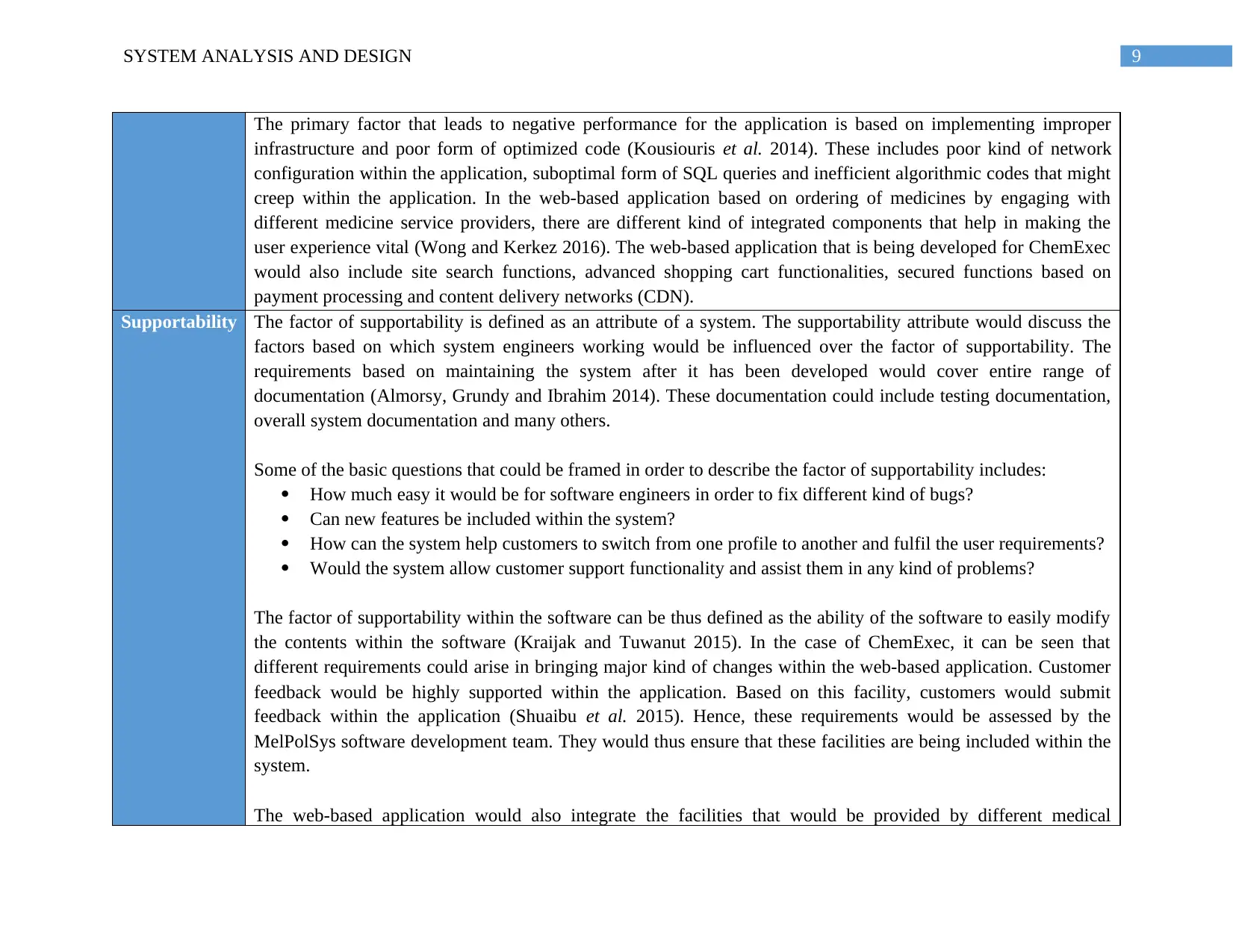
9SYSTEM ANALYSIS AND DESIGN
The primary factor that leads to negative performance for the application is based on implementing improper
infrastructure and poor form of optimized code (Kousiouris et al. 2014). These includes poor kind of network
configuration within the application, suboptimal form of SQL queries and inefficient algorithmic codes that might
creep within the application. In the web-based application based on ordering of medicines by engaging with
different medicine service providers, there are different kind of integrated components that help in making the
user experience vital (Wong and Kerkez 2016). The web-based application that is being developed for ChemExec
would also include site search functions, advanced shopping cart functionalities, secured functions based on
payment processing and content delivery networks (CDN).
Supportability The factor of supportability is defined as an attribute of a system. The supportability attribute would discuss the
factors based on which system engineers working would be influenced over the factor of supportability. The
requirements based on maintaining the system after it has been developed would cover entire range of
documentation (Almorsy, Grundy and Ibrahim 2014). These documentation could include testing documentation,
overall system documentation and many others.
Some of the basic questions that could be framed in order to describe the factor of supportability includes:
How much easy it would be for software engineers in order to fix different kind of bugs?
Can new features be included within the system?
How can the system help customers to switch from one profile to another and fulfil the user requirements?
Would the system allow customer support functionality and assist them in any kind of problems?
The factor of supportability within the software can be thus defined as the ability of the software to easily modify
the contents within the software (Kraijak and Tuwanut 2015). In the case of ChemExec, it can be seen that
different requirements could arise in bringing major kind of changes within the web-based application. Customer
feedback would be highly supported within the application. Based on this facility, customers would submit
feedback within the application (Shuaibu et al. 2015). Hence, these requirements would be assessed by the
MelPolSys software development team. They would thus ensure that these facilities are being included within the
system.
The web-based application would also integrate the facilities that would be provided by different medical
The primary factor that leads to negative performance for the application is based on implementing improper
infrastructure and poor form of optimized code (Kousiouris et al. 2014). These includes poor kind of network
configuration within the application, suboptimal form of SQL queries and inefficient algorithmic codes that might
creep within the application. In the web-based application based on ordering of medicines by engaging with
different medicine service providers, there are different kind of integrated components that help in making the
user experience vital (Wong and Kerkez 2016). The web-based application that is being developed for ChemExec
would also include site search functions, advanced shopping cart functionalities, secured functions based on
payment processing and content delivery networks (CDN).
Supportability The factor of supportability is defined as an attribute of a system. The supportability attribute would discuss the
factors based on which system engineers working would be influenced over the factor of supportability. The
requirements based on maintaining the system after it has been developed would cover entire range of
documentation (Almorsy, Grundy and Ibrahim 2014). These documentation could include testing documentation,
overall system documentation and many others.
Some of the basic questions that could be framed in order to describe the factor of supportability includes:
How much easy it would be for software engineers in order to fix different kind of bugs?
Can new features be included within the system?
How can the system help customers to switch from one profile to another and fulfil the user requirements?
Would the system allow customer support functionality and assist them in any kind of problems?
The factor of supportability within the software can be thus defined as the ability of the software to easily modify
the contents within the software (Kraijak and Tuwanut 2015). In the case of ChemExec, it can be seen that
different requirements could arise in bringing major kind of changes within the web-based application. Customer
feedback would be highly supported within the application. Based on this facility, customers would submit
feedback within the application (Shuaibu et al. 2015). Hence, these requirements would be assessed by the
MelPolSys software development team. They would thus ensure that these facilities are being included within the
system.
The web-based application would also integrate the facilities that would be provided by different medical
Paraphrase This Document
Need a fresh take? Get an instant paraphrase of this document with our AI Paraphraser
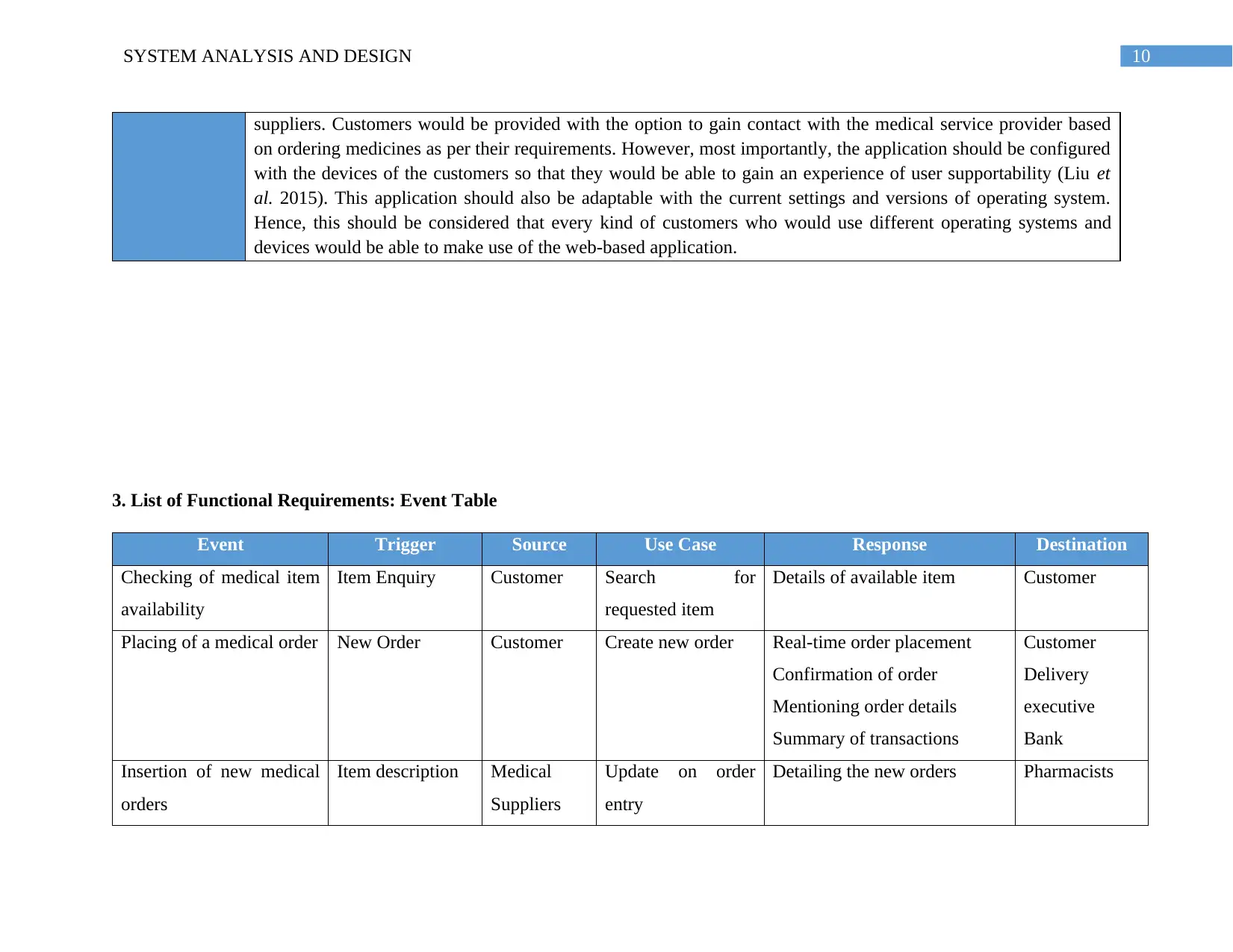
10SYSTEM ANALYSIS AND DESIGN
suppliers. Customers would be provided with the option to gain contact with the medical service provider based
on ordering medicines as per their requirements. However, most importantly, the application should be configured
with the devices of the customers so that they would be able to gain an experience of user supportability (Liu et
al. 2015). This application should also be adaptable with the current settings and versions of operating system.
Hence, this should be considered that every kind of customers who would use different operating systems and
devices would be able to make use of the web-based application.
3. List of Functional Requirements: Event Table
Event Trigger Source Use Case Response Destination
Checking of medical item
availability
Item Enquiry Customer Search for
requested item
Details of available item Customer
Placing of a medical order New Order Customer Create new order Real-time order placement
Confirmation of order
Mentioning order details
Summary of transactions
Customer
Delivery
executive
Bank
Insertion of new medical
orders
Item description Medical
Suppliers
Update on order
entry
Detailing the new orders Pharmacists
suppliers. Customers would be provided with the option to gain contact with the medical service provider based
on ordering medicines as per their requirements. However, most importantly, the application should be configured
with the devices of the customers so that they would be able to gain an experience of user supportability (Liu et
al. 2015). This application should also be adaptable with the current settings and versions of operating system.
Hence, this should be considered that every kind of customers who would use different operating systems and
devices would be able to make use of the web-based application.
3. List of Functional Requirements: Event Table
Event Trigger Source Use Case Response Destination
Checking of medical item
availability
Item Enquiry Customer Search for
requested item
Details of available item Customer
Placing of a medical order New Order Customer Create new order Real-time order placement
Confirmation of order
Mentioning order details
Summary of transactions
Customer
Delivery
executive
Bank
Insertion of new medical
orders
Item description Medical
Suppliers
Update on order
entry
Detailing the new orders Pharmacists
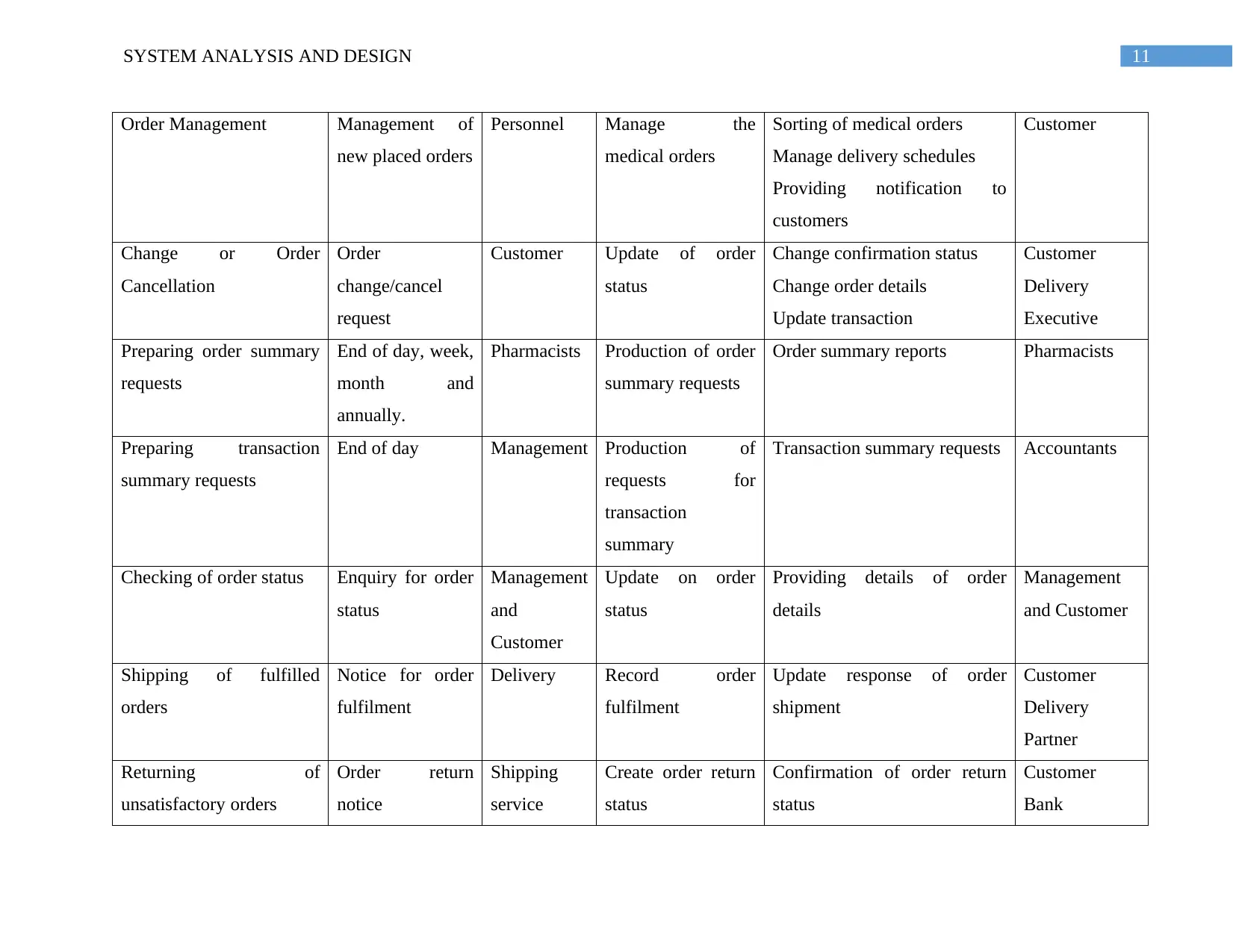
11SYSTEM ANALYSIS AND DESIGN
Order Management Management of
new placed orders
Personnel Manage the
medical orders
Sorting of medical orders
Manage delivery schedules
Providing notification to
customers
Customer
Change or Order
Cancellation
Order
change/cancel
request
Customer Update of order
status
Change confirmation status
Change order details
Update transaction
Customer
Delivery
Executive
Preparing order summary
requests
End of day, week,
month and
annually.
Pharmacists Production of order
summary requests
Order summary reports Pharmacists
Preparing transaction
summary requests
End of day Management Production of
requests for
transaction
summary
Transaction summary requests Accountants
Checking of order status Enquiry for order
status
Management
and
Customer
Update on order
status
Providing details of order
details
Management
and Customer
Shipping of fulfilled
orders
Notice for order
fulfilment
Delivery Record order
fulfilment
Update response of order
shipment
Customer
Delivery
Partner
Returning of
unsatisfactory orders
Order return
notice
Shipping
service
Create order return
status
Confirmation of order return
status
Customer
Bank
Order Management Management of
new placed orders
Personnel Manage the
medical orders
Sorting of medical orders
Manage delivery schedules
Providing notification to
customers
Customer
Change or Order
Cancellation
Order
change/cancel
request
Customer Update of order
status
Change confirmation status
Change order details
Update transaction
Customer
Delivery
Executive
Preparing order summary
requests
End of day, week,
month and
annually.
Pharmacists Production of order
summary requests
Order summary reports Pharmacists
Preparing transaction
summary requests
End of day Management Production of
requests for
transaction
summary
Transaction summary requests Accountants
Checking of order status Enquiry for order
status
Management
and
Customer
Update on order
status
Providing details of order
details
Management
and Customer
Shipping of fulfilled
orders
Notice for order
fulfilment
Delivery Record order
fulfilment
Update response of order
shipment
Customer
Delivery
Partner
Returning of
unsatisfactory orders
Order return
notice
Shipping
service
Create order return
status
Confirmation of order return
status
Customer
Bank
⊘ This is a preview!⊘
Do you want full access?
Subscribe today to unlock all pages.

Trusted by 1+ million students worldwide
1 out of 17
Related Documents
Your All-in-One AI-Powered Toolkit for Academic Success.
+13062052269
info@desklib.com
Available 24*7 on WhatsApp / Email
![[object Object]](/_next/static/media/star-bottom.7253800d.svg)
Unlock your academic potential
Copyright © 2020–2025 A2Z Services. All Rights Reserved. Developed and managed by ZUCOL.




